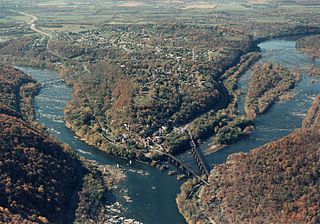| Coeymans Creek(O-nis-ke-thau) | |
| Onesquethaw Creek,Oniskethau Kil | |
| River | |
| Country | United States |
|---|---|
| State | New York |
| County | Albany |
| Towns | Bethlehem, Coeymans |
| Source | |
| - location | Bethlehem, New York |
| - coordinates | 42°32′19″N73°49′40″W / 42.53861°N 73.82778°W |
| Mouth | Hudson River |
| - location | Coeymans, New York |
| - elevation | 0 ft (0 m) |
| - coordinates | 42°28′34″N73°47′23″W / 42.47611°N 73.78972°W Coordinates: 42°28′34″N73°47′23″W / 42.47611°N 73.78972°W |
Onesquethaw and Coeymans Creeks | |
Coeymans Creek [1] is a 7.3-mile-long (11.7 km) [2] tributary of the Hudson River in Albany County, New York in the United States.

A tributary or affluent is a stream or river that flows into a larger stream or main stem river or a lake. A tributary does not flow directly into a sea or ocean. Tributaries and the main stem river drain the surrounding drainage basin of its surface water and groundwater, leading the water out into an ocean.

The Hudson River is a 315-mile (507 km) river that flows from north to south primarily through eastern New York in the United States. The river originates in the Adirondack Mountains of Upstate New York, flows southward through the Hudson Valley to the Upper New York Bay between New York City and Jersey City. It eventually drains into the Atlantic Ocean at New York Harbor. The river serves as a political boundary between the states of New Jersey and New York at its southern end. Further north, it marks local boundaries between several New York counties. The lower half of the river is a tidal estuary, deeper than the body of water into which it flows, occupying the Hudson Fjord, an inlet which formed during the most recent period of North American glaciation, estimated at 26,000 to 13,300 years ago. Tidal waters influence the Hudson's flow from as far north as the city of Troy.

Albany County is a county in the state of New York, in the United States. Its northern border is formed by the Mohawk River, at its confluence with the Hudson River, which is on the east. As of the 2010 census, the population was 304,204. The county seat is Albany, the state capital of New York. As originally established by the English government in the colonial era, Albany County had an indefinite amount of land, but has had an area of 530 square miles (1,400 km2) since March 3, 1888. The county is named for the Duke of York and of Albany, who became James II of England.
Contents
The creek originates as the continuation of Onesquethaw Creek, [3] which starts near Clarksville, in the Helderberg Mountains.

Onesquethaw Creek is a 14.5-mile-long (23.3 km) creek in Albany County, New York. It is a tributary of the Hudson River. It rises in the town of New Scotland, to the west of the hamlet of New Salem, in the Helderberg Mountains, and flows to Coeymans Creek in the town of Bethlehem, southwest of Delmar.

Clarksville is a hamlet in the town of New Scotland, Albany County, New York. It is situated along Delaware Turnpike in the southern part of the town at the foot of the Helderberg Escarpment. It is the site of the Clarksville Cave and has an annual Clarksville Heritage Day and Car Show. It is in the Onesquethaw Volunteer Fire Company fire protection district.

The Helderberg Escarpment also known as Helderberg Mountains is an escarpment and mountain range in eastern New York, roughly 11 miles (18 km) west of the city of Albany. The escarpment rises steeply from the Hudson Valley below, with an elevation difference of approximately 700 feet over a horizontal distance of approximately 2,000 feet. Much of the escarpment is within John Boyd Thacher State Park, and has views of the Hudson Valley and the Albany area.










